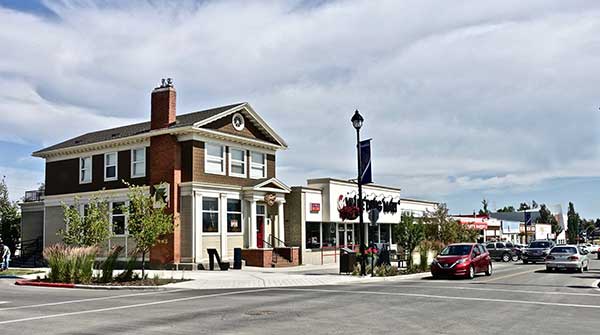The Canadian Dream is increasingly being realized in smaller areas
 For decades, Canadians moved to the larger cities (census metropolitan areas, or CMAs) with their economic opportunities. The latest estimates indicate that CMAs have 72 per cent of the nation’s population. Yet recent data shows Canadians are moving away from the CMAs, to smaller communities.
For decades, Canadians moved to the larger cities (census metropolitan areas, or CMAs) with their economic opportunities. The latest estimates indicate that CMAs have 72 per cent of the nation’s population. Yet recent data shows Canadians are moving away from the CMAs, to smaller communities.
But first, a bit of background.
Statistics Canada divides the nation into CMAs, Census Agglomerations (CAs) and areas outside CMAs and CAs. CMAs and CAs are labour markets “formed by one or more adjacent municipalities centred on a population centre (core)” with the municipalities having a “high degree of integration with the core as measured by commuting flows. CMAs have at least 100,000 residents and CAs 10,000. CMAs and CAs are much more than their core municipalities, after which they are named.
 Strathmore Alberta |
| Related Stories |
| Feds must fix flawed housing benefit
|
| How to deal with the high cost of housing and energy
|
| Cities have to expand for house prices to fall
|
For example, the Toronto CMA largely includes all the territory between Oakville, Ajax, Lake Simcoe and Mono (map), and the city of Toronto has only 45 per cent of the residents. The city of Vancouver has only 25 per cent of the CMA population.
Moreover, these geographies are not the same thing as rural versus urban. CMAs and CAs have much more rural land than urban.
Statistics Canada estimates that the 35 CMAs lost 252,000 net internal migrants (residents moving across provincial boundaries) to other parts of the country between 2017/2018 and 2021/2022. This is a considerable loss and compares to a net gain of 6,000 in the previous five years. Some of this large increase is related to the COVID pandemic, as households moved to smaller communities, taking advantage of remote and hybrid working arrangements.
The largest loss was in the largest CMA, Toronto, out of which a net 325,000 moved, 93 per cent of whom moved elsewhere in Ontario, such as Guelph, Peterborough and London. In the previous five years, the Toronto CMA had lost 183,000 net internal migrants.
The situation was similar in the Montreal CMA, which lost 145,000 net internal migrants, with 83 per cent moving elsewhere in Quebec, such as Sherbrooke, Granby and Lachute.
The Vancouver CMA lost 65,000 net internal migrants, moving to other parts of British Columbia, such as Chilliwack, Kelowna and Courtenay. This loss was well above the 40,000 in the previous five years. Unlike the two larger CMAs, Vancouver gained net interprovincial migrants (25,000), reducing the overall net internal migration loss.
The other three major CMAs, Ottawa-Gatineu (28,000), Calgary (19,000) and Edmonton (18,000), all posted net internal migration gains.
The 117 CAs gained 125,000 net internal migrants, 94 per cent of whom moved within the same province. This is a substantial increase from the 36,000 gain in the previous five years.
But the largest net internal migration gain was outside the CMAs and CAs, at 127,000. This compares to a 41,000 loss in the previous five years. These are areas where population centres have fewer than 10,000 residents.
Meanwhile, the Maritimes have reversed their long negative internal migration. The Halifax CMA gained 23,000 net internal migrants, more than Calgary or Edmonton, despite having less than one-third of their populations. The Halifax gain was a far lower 4,000 in the previous five years. New Brunswick had gains, such as in the Moncton and Saint John CMAs and the Fredericton CA. In Prince Edward Island, the Charlottetown and Summerside CAs had small gains.
None of this is to suggest that the CMAs are losing. Strong population growth continues in many, with more births and deaths and international migration (immigration). Moreover, some of the recent increase in net internal migration does appear to have been driven by the pandemic, especially the growth in working at home.
But the trends were already evident before. Analysts have cited notoriously high house prices as instrumental in the movement away from the largest CMAs. Mike Moffat, founding director of the PLACE Centre think tank in Toronto, told the Globe and Mail, “This is people moving to London (Ontario) or Moncton or basically outside of the economic region. So this is a fundamental difference.”
The Canadian Dream for both aspiring natives and immigrants could be increasingly realized in smaller areas, not only in central Canada, the Prairies and the West, but also even in the Maritimes.
Wendell Cox is a senior fellow with the Frontier Centre for Public Policy and author of Demographia International Housing Affordability.
For interview requests, click here.
The opinions expressed by our columnists and contributors are theirs alone and do not inherently or expressly reflect the views of our publication.
© Troy Media
Troy Media is an editorial content provider to media outlets and its own hosted community news outlets across Canada.

